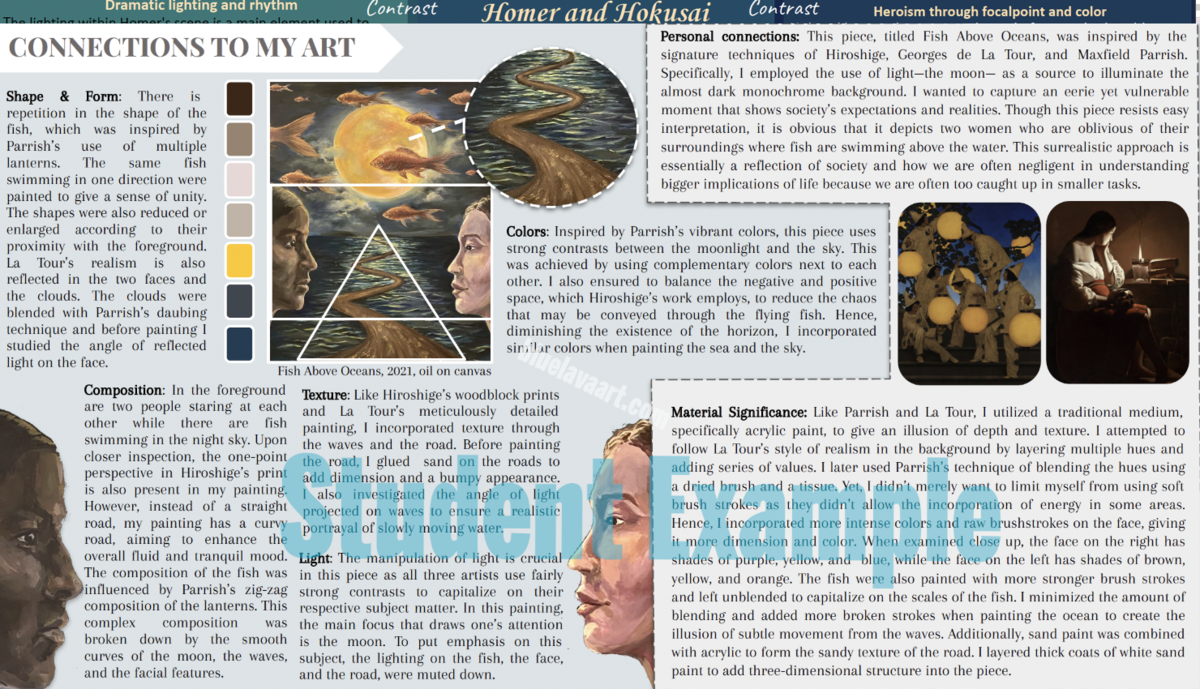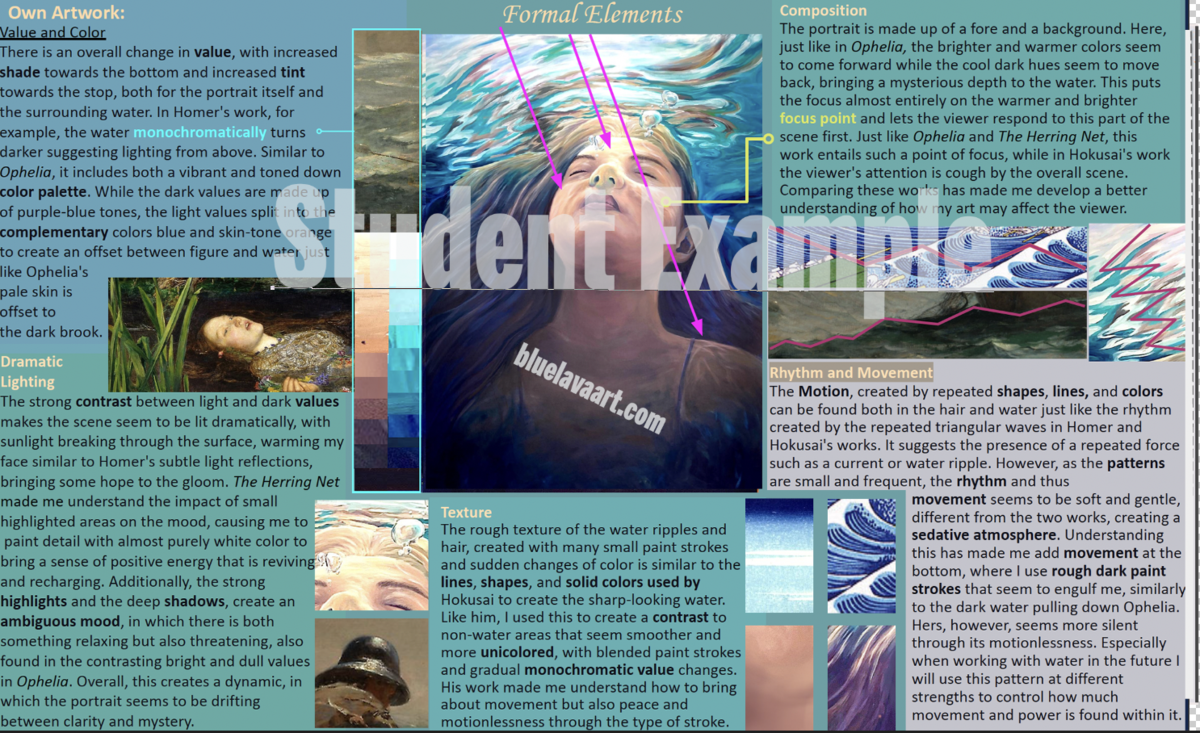What is the CS?
Comparative Study- 20% of Exam [30 points(SL), 42 points(HL)]. External Exam (assessed by IB).
Compare and contrast at least 3 artworks from at least 2 different artists of similar subject matter from 2 different cultures and (or) time periods. (They must be from different cultures). The study explores the formal qualities, meaning, and the material, conceptual, and/or cultural significance of the artworks. The final format of your CS will be submitted to IB in a Google Slides or similar type of presentation. The work selected for comparison should come from contrasting contexts (local, national, international, and/or intercultural). Ideally, students should see one of the works firsthand.
- SL 10-15 slides
- HL 10-15 slides + 3-5 slides (Criteria F) which analyze the extent to which their work has been influenced by the art and artists examined. Even though you may not have created the works that you will use for your CS, choose a genre/subject or an artist that uses techniques that interest you.
MLA Citations for ALL Sources! See the chart below in the "Related Resources"
Timeline: You will have some smaller assessments to build up to your first draft. Your first draft is due toward the end of IB1 and your final draft will be due in 12th grade. You will meet with your teacher 3 times during the process (minimum) to discuss and document your process and submit a form to IB regarding those meetings.
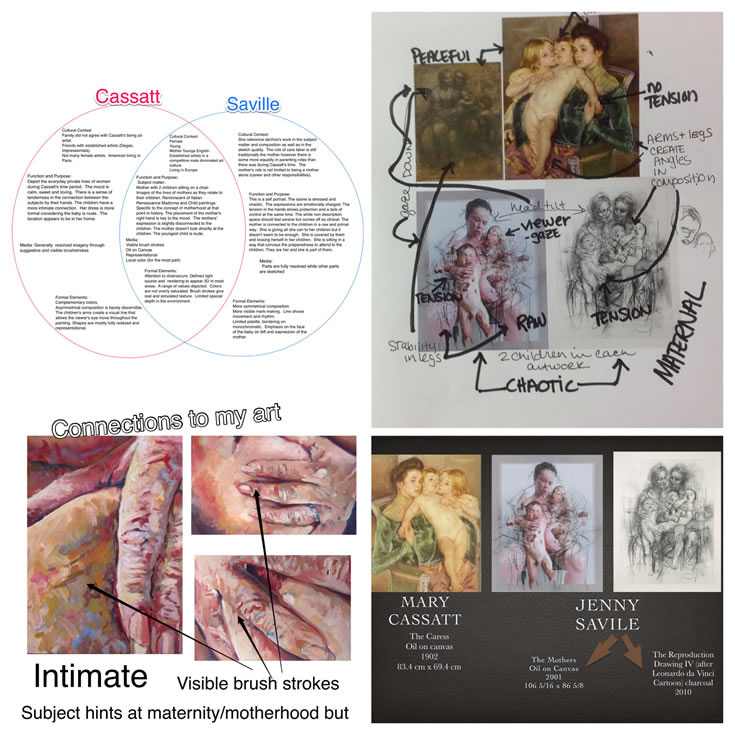
Click here to see a detailed PDF Teacher Example of the Comparative Study
Note: This example would not earn a 42 for HL. Criteria F is a bit weak, some of the cultural significance should be linked directly to the works I am comparing and there is still room for some analysis throughout.
Choosing Artists??
Who can you choose? Artwork shown in museums or galleries or they have had articles written about them by reputable sources (example: Street Artists). See your teacher if you are unsure if your selection is suitable. You can choose artists from social media, like Instagram. There are tons to choose from however, only choose one 1from that source. Otherwise, it might be challenging to build up the cultural significance.
The work selected for comparison should come from contrasting contexts (local, national, international and/or intercultural). Ideally students should see one of the works firsthand.
Some Resources
- Check out the school library: Both books and magazines!
- Here is a list of Artists and Art Historical Resources
- NY Times The Most Important Moments in Art in 2020
- Google Arts and Culture
- Art News Magazine
Note: I have broken up the criteria with a series of questions but a really good CS will have overlap between the criteria.
IB Suggested layout- Page 49 of the IB Visual Arts Guide
Criteria A- Formal Analysis (6 Points)
3-4 Slides including an introduction slide with all 3 artworks and introduction to the CS. Demonstrate an effective identification and analysis of the formal qualities of the selected artworks, objects and artifacts.
Criteria A Top Descriptor: The work identifies and analyses the formal qualities of the selected pieces from at least two cultural origins. The analysis of these formal qualities is consistently informed and effective.
- Write 3 art critiques, one for each artwork. Use the infographic below for guidance The critique mainly addresses Criteria A and a small bit of Criteria B.
- Next, write or annotate photos of the artworks about Elements and Principles. (Criteria A) See the Elements and Principles poster in the "Related Resouces" section below. Also, use sources like these: MoMA Glossary of Art Terms and Glossary from the Tate Museum See the teacher example with the Jenny Saville artwork below.
- Describe how the work is organized as a complete composition.
- What media, process, and technique have been used in each artwork?
- Is the process used conventional or innovative?
- How have the formal qualities (art elements & principles) been used and are they effective?
- How would you evaluate the artworks?
- How is the work constructed or planned (i.e., acts, movements, lines)?

Criteria A Example Slide
Example of what 1 slide could look like. Keep in mind that it needs to be analytical. Bold Subject Specific vocabulary.
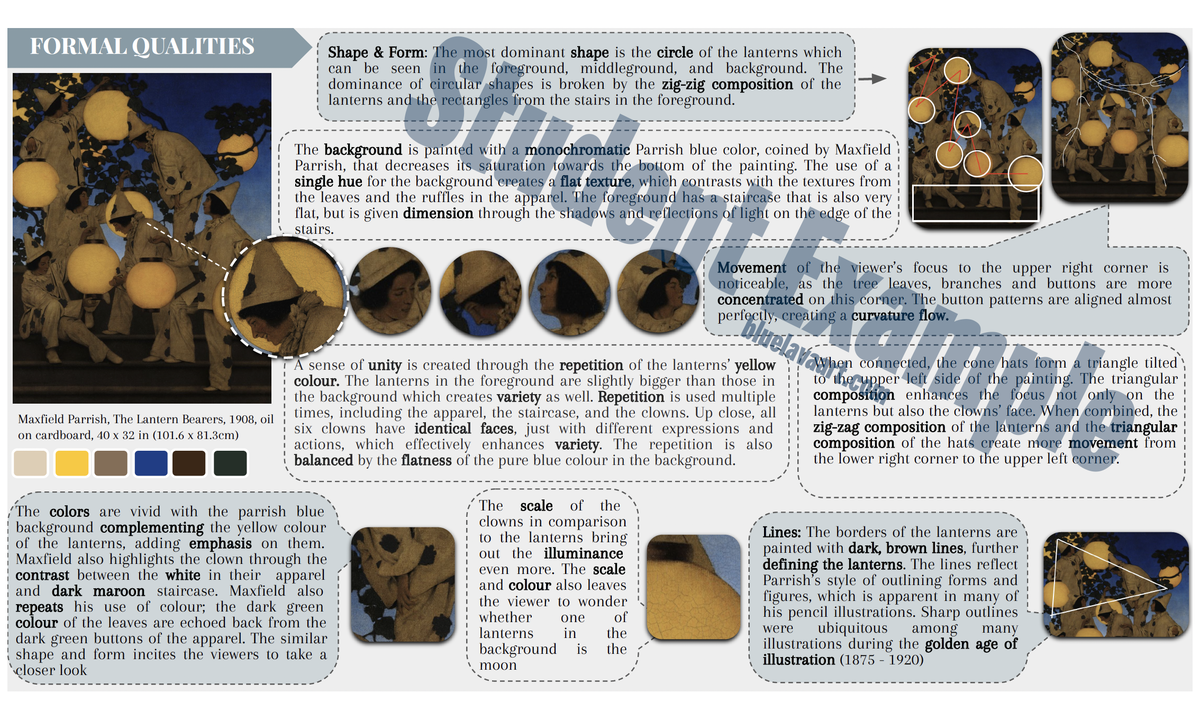
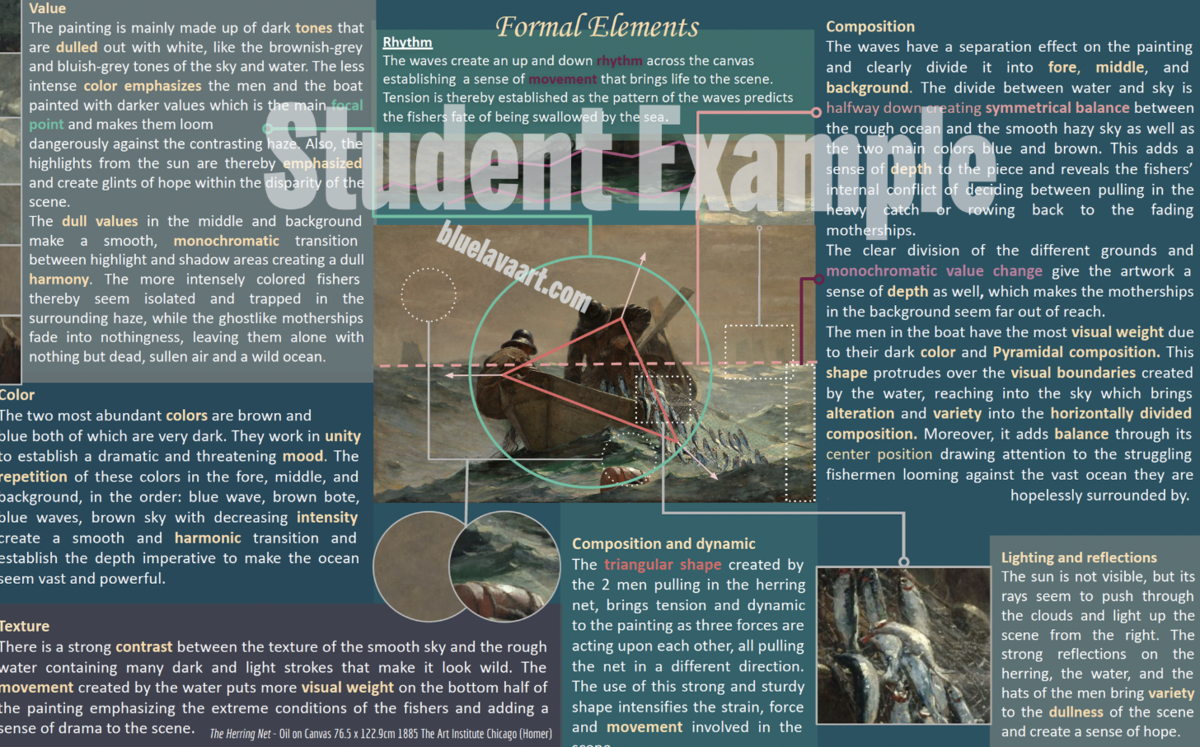
Criteria B: Function and Purpose (6 points)
2-3 Slides: Demonstrate an informed and appropriate interpretation of the function and purpose of the selected artworks, objects and artifacts within the cultural context in which they were created.
What is the mood, symbolism and interpretation of the artwork. How does the mood, symbolism and interpretation relate to the time it was created? Does the interpretation change throughout time or cultures? Annotated images of symbolic images, impact of color choices, techniques influence interpretation. Chart of symbolism relating to cultural context.
Criteria B Top Descriptor The work demonstrates a consistently informed and appropriate interpretation of the function and purpose of the selected pieces within the cultural context in which they were created.
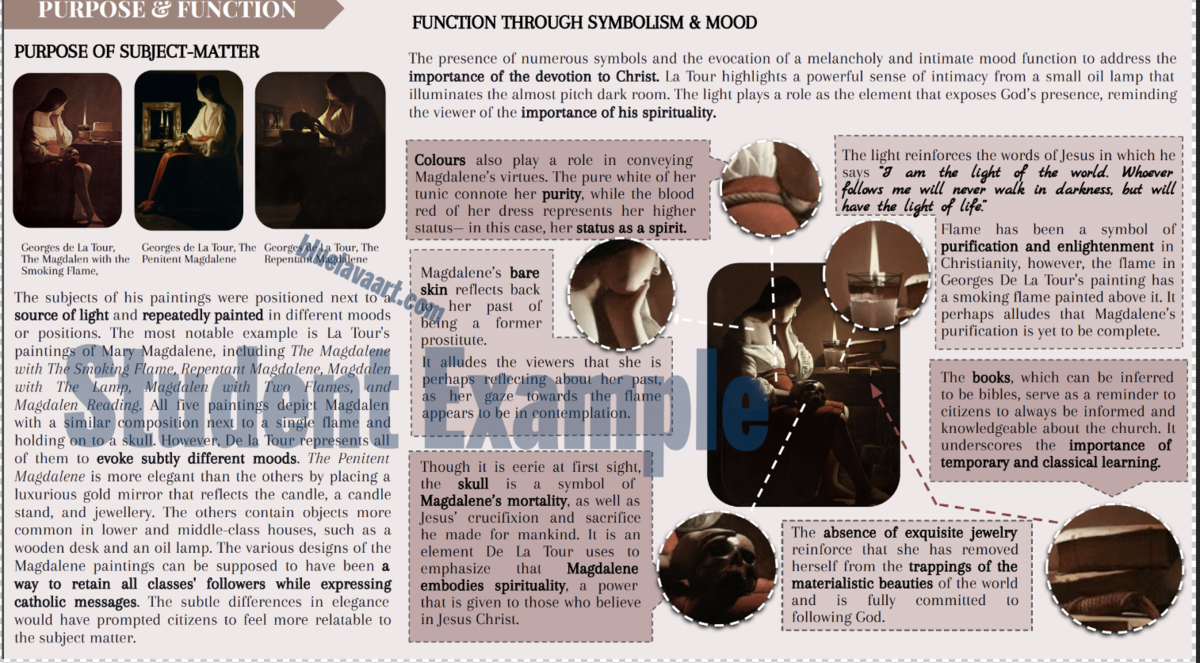
Criteria B: Build on your interpretation with these questions:
General Understanding of the Artwork:
- What is it about? What does it mean?
- Is the piece meant to be expressive, political, in protest, decorative, illustrate a historically significant event, or instructional?
- Does the artwork have a narrative (tell a story)? Is it religious, mythical, historical depiction, a portrait, abstract, or realistic? Why?
Function and Purpose:
- What is the primary function of this artwork? (Contextual, personal, intellectual, social, or physical function)
- How does the artwork's context influence its purpose? (Consider historical, cultural, and social context.)
- Was the artwork commissioned by a wealthy patron? Was its original intention meant to be art, or was it meant for another use (e.g., utilitarian object)?
Artist's Intentions and Choices:
- What message or meaning is the artist trying to convey? What choices did the artists make to effectively communicate their statement or message?
- Have the artists made any formal statements about these particular artworks or their work in general that might support your analysis?
- What signs, motifs, or symbols have been used, and what do they communicate to the audience?
Materials, Techniques, and Audience Interaction:
- How does the use of materials and techniques contribute to the artwork's function and purpose?
- How does the artwork interact with its audience? (Engagement, contemplation, emotional response)
Societal Reflection and Interpretation:
- How does the artwork reflect or challenge societal norms and values of its time?
- What kinds of statements are found in the work that reflects the culture or context in which the work was created?
- Can the artwork's purpose be interpreted differently by contemporary audiences compared to its original viewers?
Comparative Analysis:
- How does this artwork compare to others by the same artist in terms of function and purpose?
- How have the artists you chose found ways to present the information they want to communicate in their art?
Personal and Cultural Influence:
- How does the artist's personal background (culture, experiences, beliefs) influence the artwork's purpose?
- Are there any specific events or experiences in the artist's life that are reflected in the artwork?
Note: Criteria B asks you to address the meaning "within the cultural context in which is was created."This begins to overlap with Criterion C which asks more questions to consider regarding cultural context.
Criteria C: 6 Points
3-4 Slides Demonstrate an informed understanding of the cultural significance of the selected artworks, objects and artifacts within the specific context in which they were created.
Criteria C Top Descriptor: The work demonstrates consistently informed and appropriate evaluation of the material, conceptual and cultural significance of the selected pieces within the specific context in which they were created.
Material Significance:
What is it made of? What is the material significance? Does it matter what media was used to create the work?
What does this process involve? Is there a reason the material might be significant? Was the material was popular at the time? Was the material was cheap/accessible, or expensive (Used as a status symbol)
Does the material have conceptual significance (This is particularly important with many mixed media works, sculptures, and installations)? Check out this for more ways to understand Material Significance.
Conceptual Significance:
What is the message, meaning, mood, theme, the idea of the artwork? Is this significant? Why? How so? Is it saying something new or advanced for its time?
Does it belong to a particular art movement. Is the idea of this piece, or the art movement it belongs to, revolutionary or new in any way?
Cultural Significance
- When was the piece made? Where was the piece made?
- Patronage of the work (who paid for it, how and why)
- Political circumstances when the work was made
- Religious circumstances when the work was made
- Philosophical movements of the time
- Other major forms of cultural expression from the same period
- Contemporary scientific and geographic knowledge
- The original setting of the work
- The original use of the work
What was going on in the artist's life, the art world, and in the world (historical events) at the time the artwork was created? Consider using the McFee Framework to visually organize your research and analysis
- The Audience’s World? What experiences of the world does the audience bring when they interpret or appreciate the work? What are some cultural characteristics of the area? (religion, language, political) What was happening in that part of the world at the time? What was happening in the rest of the world at that time? What was life like for people in that part of the world at that period of time?
- What happened to the artwork(s) after they were painted -sold, left in an attic, on exhibit…
- The Artist’s World - personal history and art history, relate to your interpretation of the artwork. Could these events relate to the subject matter or techniques used in the artwork? What was the artist’s life like? What was the artist’s training? What position were they in socially/economically? Were there any major events or happenings in their life that influenced their artwork? Is their gender important or influential in their artwork?
- What were other artists creating during this time period?
- How did other artists deal with this theme in other times or cultures?
- The World at the time- Major events, wars, accomplishments, theories (Social, historical, political, and intellectual contexts of the work studied) and relate to the artwork.
- How does the work reflect aspects of the world when they were created.
- Is there anything else - political, social, or economic in nature- that possibly influenced the artist or inspired the artist to make this work of art?
- Was/is the artwork controversial?
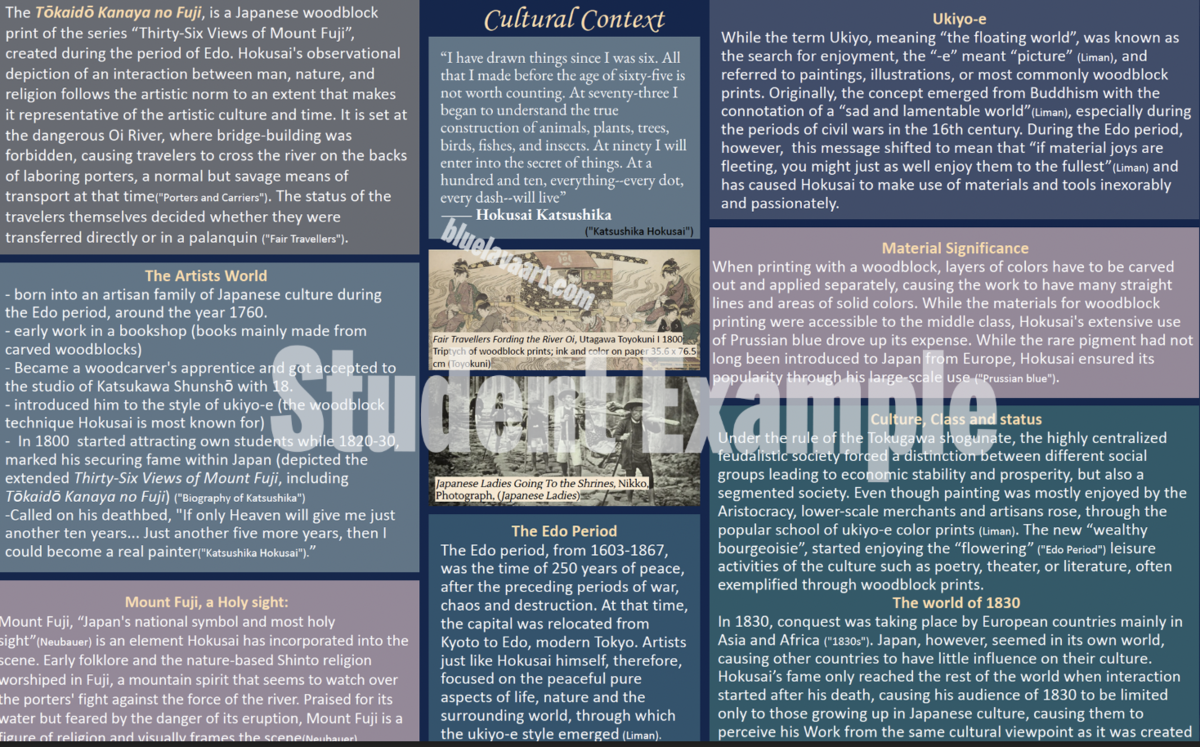
Criteria C Examples
- The artist’s life and training-Albrecht Dürer’s father was a goldsmith, and he received training in his workshop as a very young boy.
- Patronage of the work (who paid for it, how and why)-Pope Julius II paid Michelangelo for the Sistine Chapel, after being convinced to do so by Raphael and Bramante, who wanted to see the remarkable young sculptor fail at this massive painting project.
- Political circumstances when the the work was made-Goya created his Los Capricos etchings in part as a response to his disillusionment with Spanish politics.
- Religious circumstances when the the work was made-As popular piety grew in Renaissance Flanders, laypeople began to worship on their own, creating a market for personal home altars like the Merode Altarpiece.
- Philosophical movements of the time-The philosophical viewpoint of the Enlightenment suggested that civilization could be perfected over time, and Hogarth worked to encourage this with overtly moralizing tales in paintings and prints.
- Other major forms of cultural expression from the same period-The long, smooth barrel vaults of Romanesque churches were perfectly suited to Gregorian (or Plainsong) chant, popular at the time, with its long, low, simple monophonic melodies.
- Contemporary scientific and geographic knowledge-The maps of Abraham Ortelius were based on history, myth, and recent scientific observations.
- Original setting of the work- tea bowls were designed not for display in museums but for use in simple, rustic tea houses, such as those designed by Sen no Rikyu.
- Original use of the work-Dogon masks were never made to be displayed in glass vitrines in museums, but rather, were made to be worn by dancers in ritual performances.
Example Text from http://www.arthistoryrules.com/Essay_Writing/Context.html
Criteria D: 6 points
2-3 slides: Demonstrate an effective identification and critical analysis of the connections, similarities and differences between the selected artworks, objects and artifacts.
At the highest level of achievement, the work critically analyses the connections, similarities and differences between the selected pieces. These connections are logical and coherent, showing a thorough understanding of how the pieces compare.
- Critical analysis of connections, similarities and differences between the selected artworks. Use charts, tables, drawing diagrams to help support your statements. Compare across all of the different criteria.
Present your comparisons of the different pieces, clearly identifying links between them. These comparisons might include:
- comparing the cultural contexts of the selected pieces
- comparing the formal qualities of the selected pieces
- comparing the function and purpose of the selected pieces
- comparing the material, conceptual, and cultural significance of the pieces.
- Not just described or listed similarities and differences.
- Use charts, tables, drawing diagrams to help support your statements. Tip: Venn Diagrams are hard to read. Use tables instead.
- Create a timeline of your artists, art movements, or events.
- Create analytical approaches where you create/identify connections!
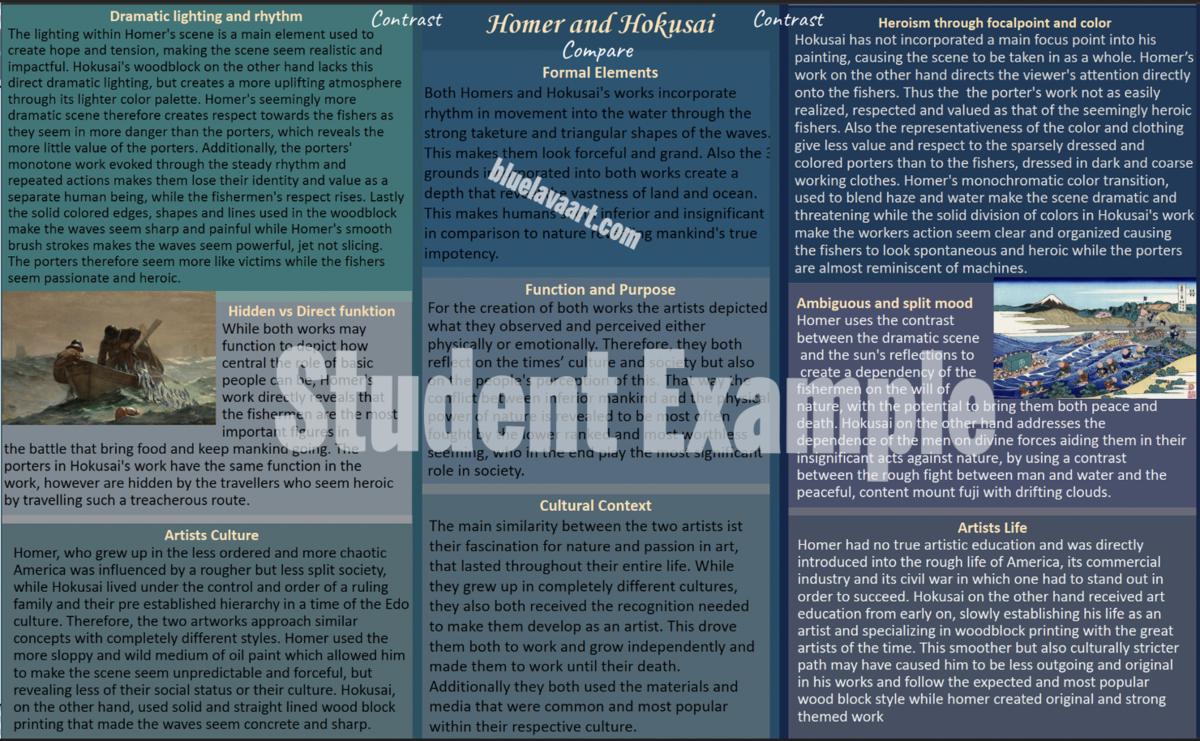
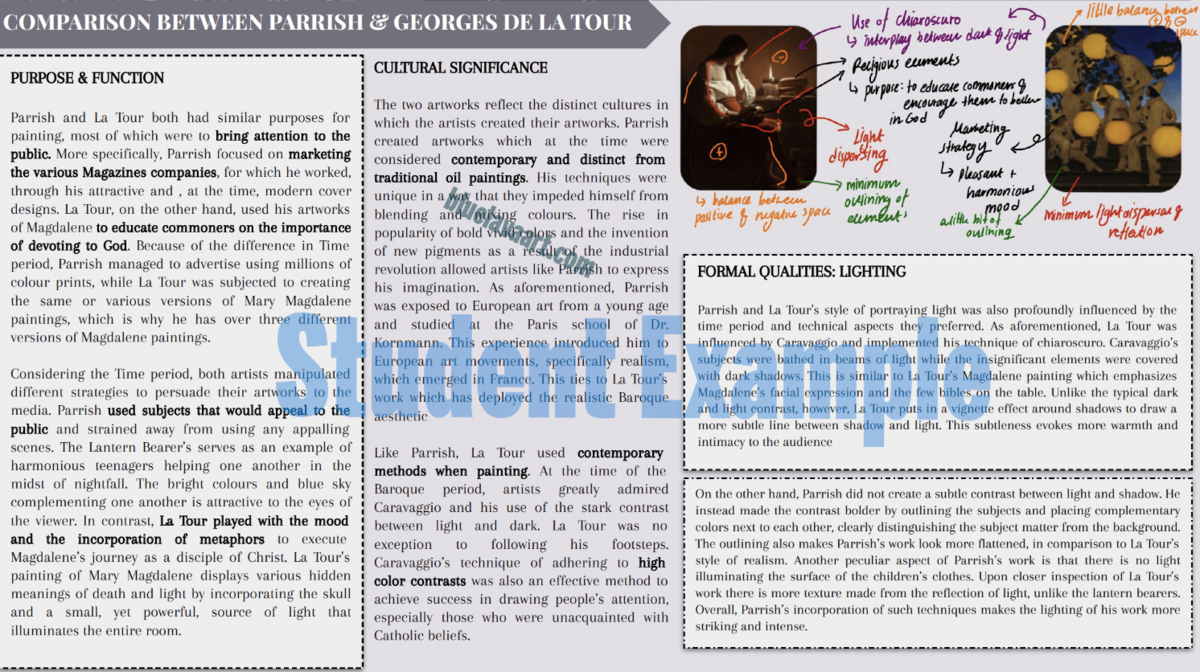
Criteria E: 4 points
Throughout all of the slides: Presentation & Visual Art Vocabulary: ensure that information is conveyed clearly and coherently in a
visually appropriate and legible manner, supported by the consistent use of appropriate subject-specific language. Make it look pretty too!
Criteria E Top Descriptor: At the highest level of achievement, the work clearly and coherently conveys information which results in a visually appropriate, legible and engaging study. Subject-specific language is used accurately and appropriately throughout.
- Design: Use your "real estate" (The space available on the slides) wisely. Use a consistent design scheme for your presentation.
- Make slide backgrounds subtle and consistent and use high contrast between background and text color.
- Fonts: Don't use fonts that are smaller than 10 pt. Captions can be 8 point.
- Use one or two fonts throughout the presentation. Sans serif fonts tend to be easier to read on-screen. Avoid narrow or cursive fonts.
- Images: Wherever possible, communicate with visuals and graphics in preference to text.
- Use figures and captions. Resize images first to a maximum height or width of 1,500 pixels, optimized for web and devices. This will significantly reduce the overall size of your file, without compromising the image quality when viewed on a screen.
- Check your grammar and spelling, paying particular attention to the spelling of artists’ names and subject-specific terminology.
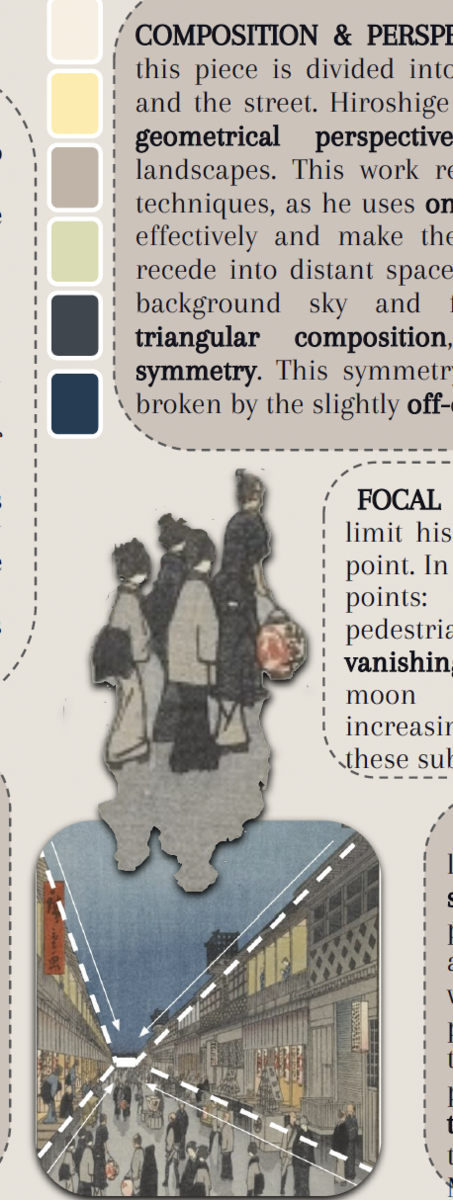
Criteria F: (HL Only) 12 points
3-5 slides Demonstrate analysis and reflection on the outcomes (conclusion) of the comparative study investigation and on how this has influenced your own development as an artist, identifying connections between one or more of the selected works and your own art-making processes and practices.
Criteria F Top Descriptor: the work analyses and reflects upon the outcomes of the investigation consistently and appropriately. You effectively consider your own development, making informed and meaningful connections to your own art-making practice.
These influences and personal connections, which should be evidenced in both visual and written forms, might include:
- cultural context
- formal qualities
- function and purpose
- materials, conceptual, and cultural significance.
When referring to your own artwork and practices, you must be sure to identify and acknowledge your own artworks with the same rigorous attention to detail as with images from other sources.
Citations
Doesn't impact overall side numbers so you can have multiple slides with your references: Include a reference list of sources used during the study. In-text referencing is required throughout the comparative study. Every image used within the comparative study must be appropriately referenced to acknowledge the title, artist, date (where this information is known), and the source, following the protocol of the referencing style chosen by the school. See my MLA Citation chart
Do you have Critical Analysis in your CS?
Use these questions as a starting point to develop your analysis Comparative Study (and Process Portfolio)
Consider analysis being an equation. The artist did this + the artist did this = effect in the artwork
- Use aesthetic theories to help you evaluate
- Evidence: What evidence inside or outside the artwork supports your interpretation?
- Criteria: What criteria do I think are most appropriate for judging the artwork? Is it a good artwork? Present your opinion of the work's success or failure. What qualities of the work make you feel it is a success or failure?
- Evidence: What evidence inside or outside the artwork relates to each criterion?
- Judgment: Based on the criteria and evidence, what is my judgment about the quality of the artwork?“Franz Marc has created an effective expressive painting because the hot colors and lively brush marks he has used add to the overall feeling of energy and excitement he is trying to create.” “The overall mood of this drawing would be improved if Kathe Kollowitz had used strong, dramatic shadows, instead of pale tones. Dark tones would develop the feeling of fear and loneliness in this image.”
- What criteria can you list to help others judge this work?
- If you were inside this artwork, what would you be feeling/ thinking?
- How would you explain this artwork to someone else?
- Identify some of the similarities throughout the work and what is the result of the artist including them?
- Identify some of the points of emphasis in the work (i.e., specific scene, figure, movement). What is the effect of them?
- If the work has subjects or characters, what are the relationships between or among them?
- Describe how the work makes you think or feel. Support your statement with what in the work leads you to feel those emotions
- Describe the expressive qualities you find in the work. What expressive language would you use to describe the qualities?
- Does the work remind you of other things you have experienced (i.e., analogy or metaphor)?
- How does the work relate to other ideas or events in the world and/or in your other studies?
- How original is the work? Why do you feel this work is original or not original?
Activities to build up our skills!
Learn how to Compare and Contrast (These artists are from the same cultural context so they would not work for your CS)
Brooklyn Museum: Kehinde Wiley - Practice bringing together Criteria A, B and C
Related Resources
YouTube Playlist on Art Analysis

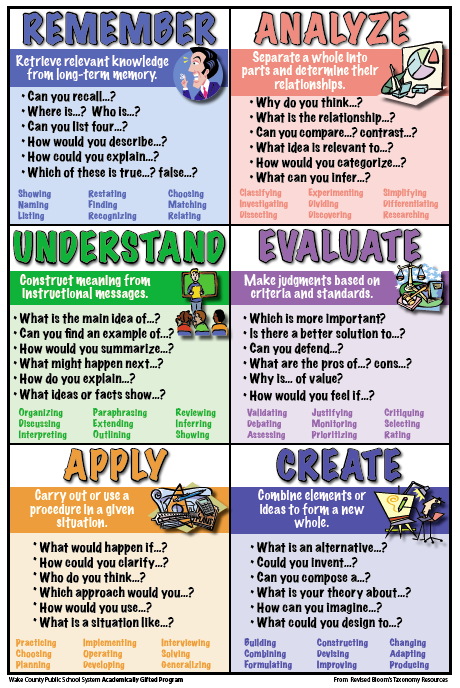
Visual Organizers and resources on Pinterest
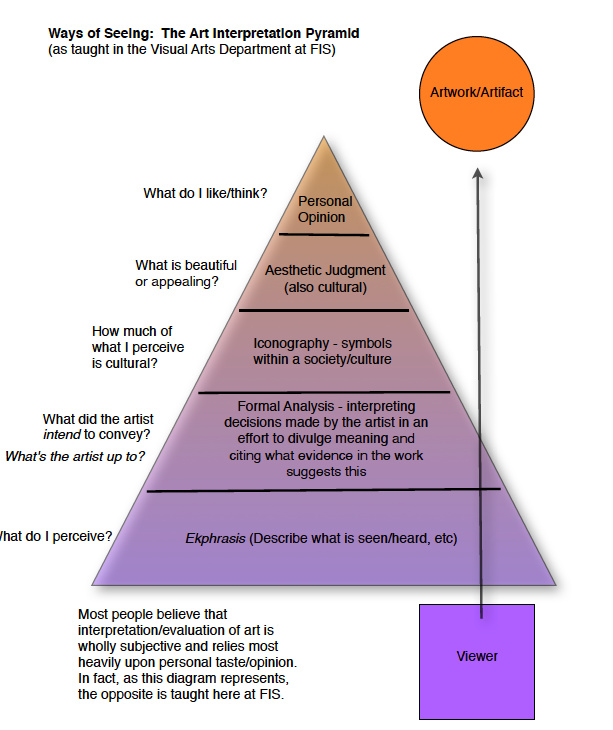
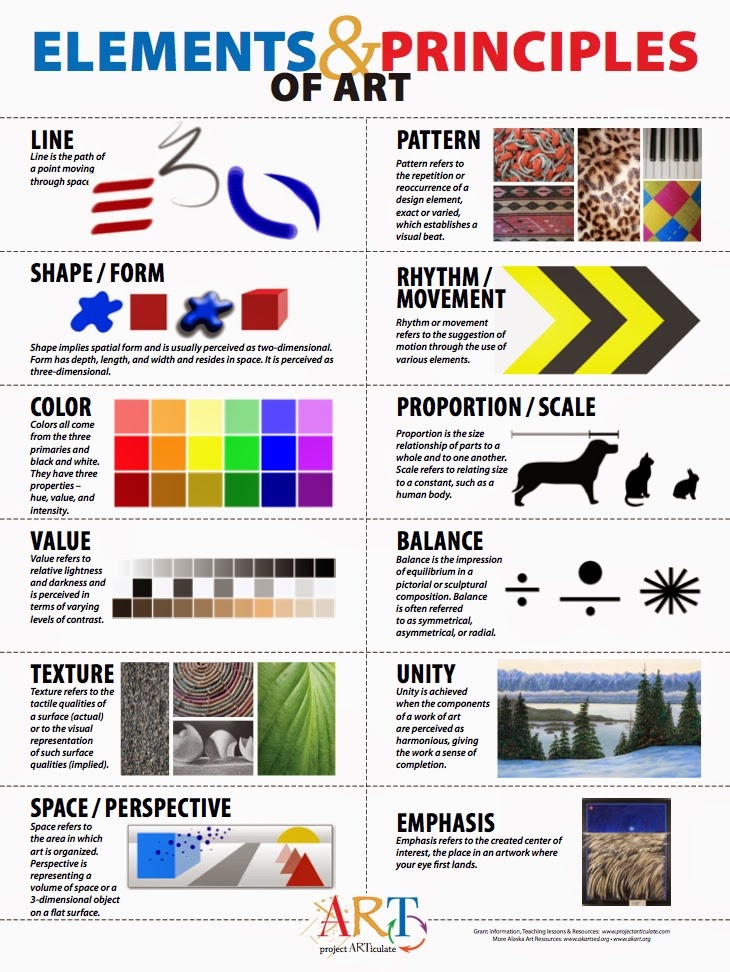
Know where your work sits with in history. Consider including a timeline of historical events, art history, artist's life.

